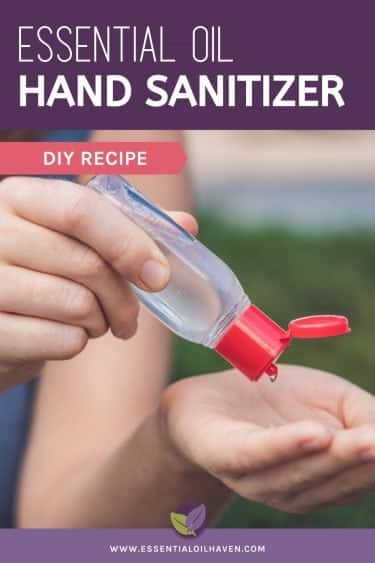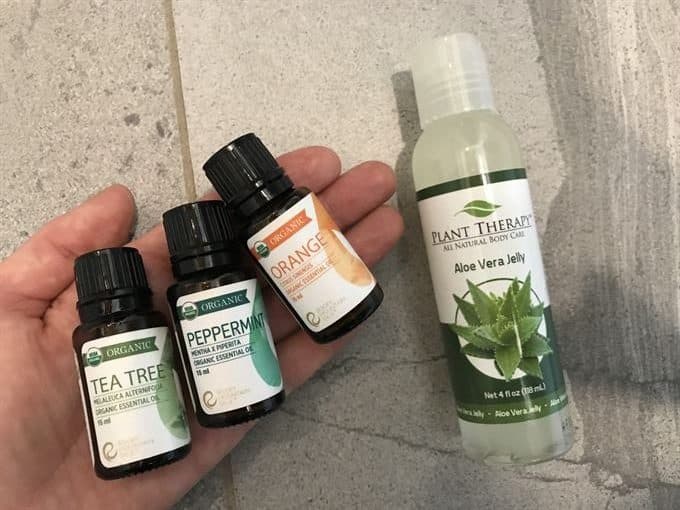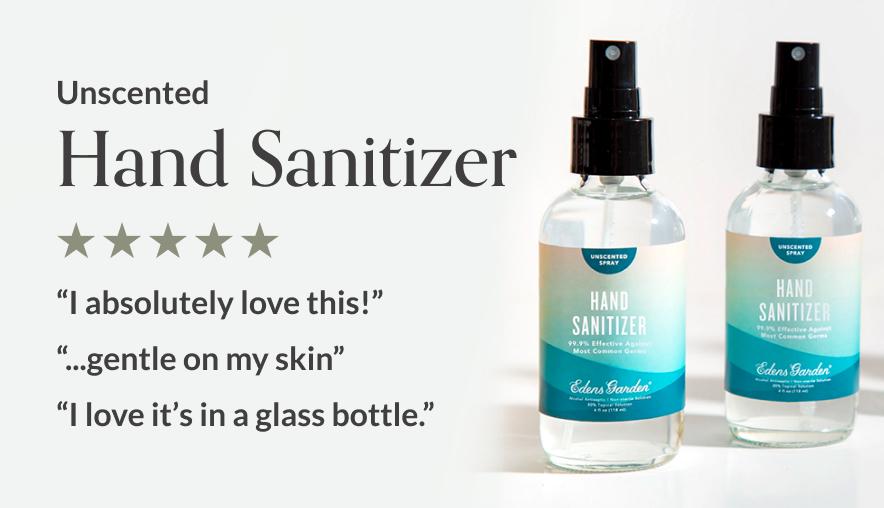
A DIY hand sanitizer do not cost a lot to make. Especially if you make some in bulk to stash in your purses or backpacks. You can save money while still getting the best hand sanitizer for your needs.
IMPORTANT: Please know that nothing homemade can be truly called a “sanitizer”. I’ve used this word solely for clarity purposes to the reader. Only commercial grade products can truly be called a sanitizer. In the U.S., Environmental Protection Agency (EPA) certification is required any time a manufacturer claims sanitizing properties ¹.
This post contains affiliate links, which means if you make a purchase through these links, I may receive a small commission at no extra cost to you. Read my full disclosure policy here.
Best Essential Oil for Hand Sanitizer
Tea tree oil (Melaleuca alternifolia) has been tested in clinical studies to kill most types of bacteria at a concentration of 1% or less. I recommend that your homemade hand purifier makes use of it. Tea tree is the best essential oil for your hand sanitizer recipe.
It’s an easy essential oil to get, and fairly inexpensive. If you have a starter kit at home, chances are you already have it in your home.
Why Alcohol-Based
Almost all hand sanitizers contain antibacterial ingredients like a sort of alcohol.
The World Health Organization recommends alcohol-based hand rubs as a quick means to “effectively inactivate a wide array of potentially harmful microorganisms on hands” ².
There are two types of alcohol: ethyl alcohol (plant based), and isopropyl (chemical based). When it comes to disinfectant properties, research shows that the two alcohols are the same ³.
This same study also reveals that ethanol tends to dry out skin more than isopropyl alcohol. The preference for skin applications is isopropyl alcohol. Ethanol is the kind of alcohol you’d drink, so it is also found in grain alcohol like Everclear. Isopropyl alcohol is chemically produced, medical grade alcohol and found in products that go by the same name.
How to Make Hand Sanitizer with Essential Oils
There are many great reasons to use a homemade hand sanitizer. The ingredients are pretty easy to get. Pleas make sure to use pure essential oils to ensure maximum potency. Fake essential oils, or stretched ones, will not have the desired effect. In my recipe, I have used USDA certified organic essential oils from Rocky Mountain Oils.
Make as much of this recipe ahead of time as you can. It’ll save you having to run back to the store for more. The alcohol in the recipe will keep the ingredients fresh. And there is no water so there will be no bacterial growth or other deteriorating of your homemade product.

Natural ingredients needed for your DIY hand purifier include essential oils and Aloe Vera gel.
Ingredients
- Small squeeze bottles (like these ones here)
- 1 oz Aloe Vera gel (like this one here)
- 3 oz of at least 90% alcohol. Use Isopropyl rubbing alcohol or Everclear grain alcohol.
- 20 drops Tea Tree essential oil
- 14 drops Peppermint essential oil
- 12 drops Sweet Orange essential oil
Instructions
- Get a few simple squeeze bottles with an easy-to-open cap.
- Combine alcohol and aloe vera gel in a glass bowl and swirl to mix.
- Add 14 drops Peppermint, 12 drops Sweet Orange, and 20 drops Tea Tree essential oils.
- Shake well to combine.
- Use as needed.
Not only will your hands smell nice, they’ll also be disinfected without the use of harsh chemicals.
Recipe Substitutions
If you wish to alter the essential oils used in this recipe, I can recommend the following substitutions:
- 15 drops of Plant Therapy’s Germ Destroyer blend (it’s Kid Safe), plus 20 drops Tea tree. Great if you have little kids around or are going through the cold and flu season.
- 15 drops of Rocky Mountain Oils’ Immune Strength blend, plus 20 drops Tea tree. Great if you wish to strengthen your immune system while keeping your hands clean.
- 35 – 40 drops of Young Living Thieves® or Alternative “Thieves” Blends.
- If you don’t have Sweet Orange at home, you can also use Lemon essential oil.
Precautions
Because this recipe uses a lot of alcohol, please use this homemade hand sanitizer sparingly. Alcohol can dry out the skin, leaving it susceptible to damage and cracking. If you can, take extra care of the skin on your hands with a natural hand cream. Lotion as frequently as you sanitize.
Also, alcohol is flammable. Please keep it out of reach of the stove, microwave, candles, and similar. Also keep it away from children to avoid accidental ingestion.
Final Thoughts
Making hand sanitizer is quick and easy. Keep plenty of these bottles around, so you can stash them everywhere you may need them: in the car, by your computer keyboard, or in your purse.
If you’re looking for an easy hand sanitizer base, have a look at Edens Garden’s unscented hand sanitizer spray. You can use it as-is, or add your essential oils recipe into it for an easy, personalized way to sanitize.

Unscented Hand Sanitizer Spray
Shop here
References
¹ Difference between Cleaning, Sanitizing and Disinfecting
² WHO-recommended hand rub formulations
³ Ethyl or isopropyl alcohol?







Hi Emma. I just have a question regarding using the thieves oil blend as an alternative. How much do I use for the recipe above? It doesn’t state it.
Hi Jillian, oh I’m so sorry about that! use 35-40 drops. I’ve corrected the information above, as well. Thanks for letting me know!
Hi Emma, of topic here but I have a question about skin irritation. I used a doterra ZenGest roller and my skin (torso area) developed a rash. Also anytime I use EO’s on my neck (not in pure form) I get a rash, however I can put it on my wrists or knees and everything is fine. Is that typical of EO? or am I just weird! Thanks for your time enjoy your site! :)
I have placed my DIY hand sanitizer in a plastic spray bottle for work.
My job is considered essential to the community that I live in.
Due to the fact that I travel between place to place I need to have something that is effective and this is one reason why I have my essential oils in a plastic spray bottle along with the rest of the ingredients for homemade hand sanitizer. So that my sanitizer is not dropped or broken in any way.
I know the different places that I travel in between appreciate the fact that I sanitize myself before I enter the building and doing various work in between each little project I sanitize my hands along with the gloves that I’m wearing.
Hi Emma,
I’m a bit confused about the idea of putting this in a plastic bottle. I put just a few drops of an EO (mixed with mineral water, I think) in a glass bottle with a plastic sprayer a while back, to use as a room freshener. It was Rosemary EO, and within about a month, the EO began to dissolve the plastic, thus ruining that mix. I’m new to essential oils, so I didn’t know that using plastic with them was a problem. But I’m just thinking, since that happened, wouldn’t it be a better idea to put this kind of thing in a glass bottle? Just curious, thanks.
Hi Tracy, thanks so much for your question! You’re right, glass is always the preferred method of storing essential oils or associated DIY products. But – I’ll have to do some more research on rosemary oil specifically and see whether it was the oil, or the type of plastic bottle you used, that caused the deformation in your DIY. This article here is a start of a discussion about different types of plastic reacting to oils. Personally, I’ve never yet seen an oil disintegrate the few plastic bottles that I do have. In this recipe, I wanted to use plastic bottles so that the product would be easy to squeeze and apply.